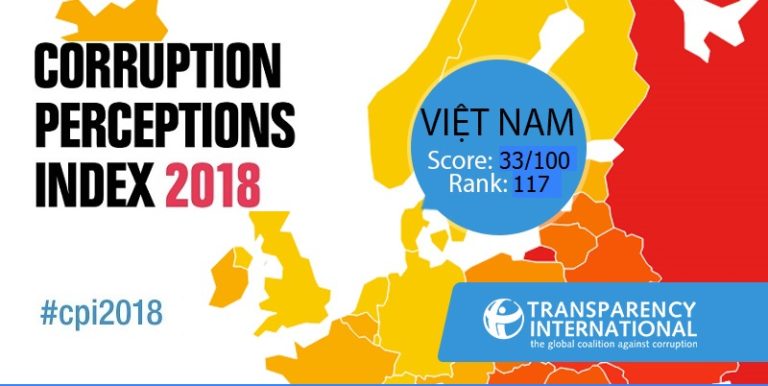Corruption Perceptions Index 2018: Corruption in Vietnam’s public sector is still perceived as highly serious

Vietnam’s result in the 2018 Corruption Perceptions Index
29 January 2019 (Hanoi time), Transparency International (TI) officially publishes its Corruption Perceptions Index 2018 (CPI 2018), ranking 180 countries and territories based on how corrupt their public sectors are perceived to be, as determined by opinions and assessments of experts and business people.
Vietnam scores 33 points out of 100 on the 2018 CPI, dropping 2 points compared with that of 2017, ranking 117 out of 180 countries surveyed. Vietnam’s 2018 CPI score is calculated on the basis of 8 data sources that draw on independent international surveys. Statistically, a two-point decrease in the index is considered insignificant. However, on the scale of 0 (highly corrupt) to 100 (very clean), this indicates that corruption in the public sector in Vietnam is still perceived as highly serious. Amongst Asia – Pacific countries surveyed this year, China, Maldives and Bangladesh also see the same point decrease as Vietnam.

Source: Transparency International (2018)
For the past years, the Communist Party and the State of Vietnam have made significant efforts in anti-corruption, notably crackdown of several high-profile corruption cases, together with the improvement of the anti-corruption legal framework (e.g. the amended Anti-Corruption Law was approved by the National Assembly in November 2018).
However, corruption remains a serious problem in Vietnam. Thus, the current fight against corruption, in particular the handling of serious corruption cases, if implemented in a fair and impartial manner, is to be continued and strengthened. This should also be accompanied with effective preventive measures, including reinforcing integrity in public sector and enhancing asset disclosure by public officials, so as for this practice to truly become an anti-corruption culture of Vietnam.
Key information about CPI
What is the Corruption Perceptions Index (CPI)?
Launched annually by Transparency International since 1995, the CPI scores and ranks countries/territories based on how corrupt a country’s public sector is perceived to be by experts and business executives. It is a composite index, a combination of 13 surveys and assessments of corruption, collected by a variety of reputable institutions. The CPI is the most widely used indicator of corruption worldwide.
Why is the CPI based on perceptions?
Corruption generally comprises illegal activities, which are deliberately hidden and only come to light through scandals, investigations or prosecutions. Whilst researchers from academia, civil society and governments have made advances in terms of objectively measuring corruption in specific sectors, to date there is no indicator which measures objective national levels of corruption directly and exhaustively. The sources and surveys which make up the CPI, ask their respondents questions which are based on carefully designed and calibrated questionnaires. The CPI contains informed views of relevant stakeholders, which generally correlate highly with objective indicators, such as citizen experiences with bribery as captured by the Global Corruption Barometer.
Further reading on CPI
FAQs on CPI
Full key messages from Towards Transparency (TT) to the Government and society of Vietnam
Transparency International’s Press release on CPI
Info-graphic on CPI
2018
2017
2016
CPI Global map – Country results of 176 countries
CPI Country results of Asia Pacific countries
Full sources description
Technical Methodology Note
2018
Short Technical Methodology Note 2018
Full Technical Methodology Note 2018
2017
Short Technical Methodology Note 2017
Full Technical Methodology Note 2017
2016